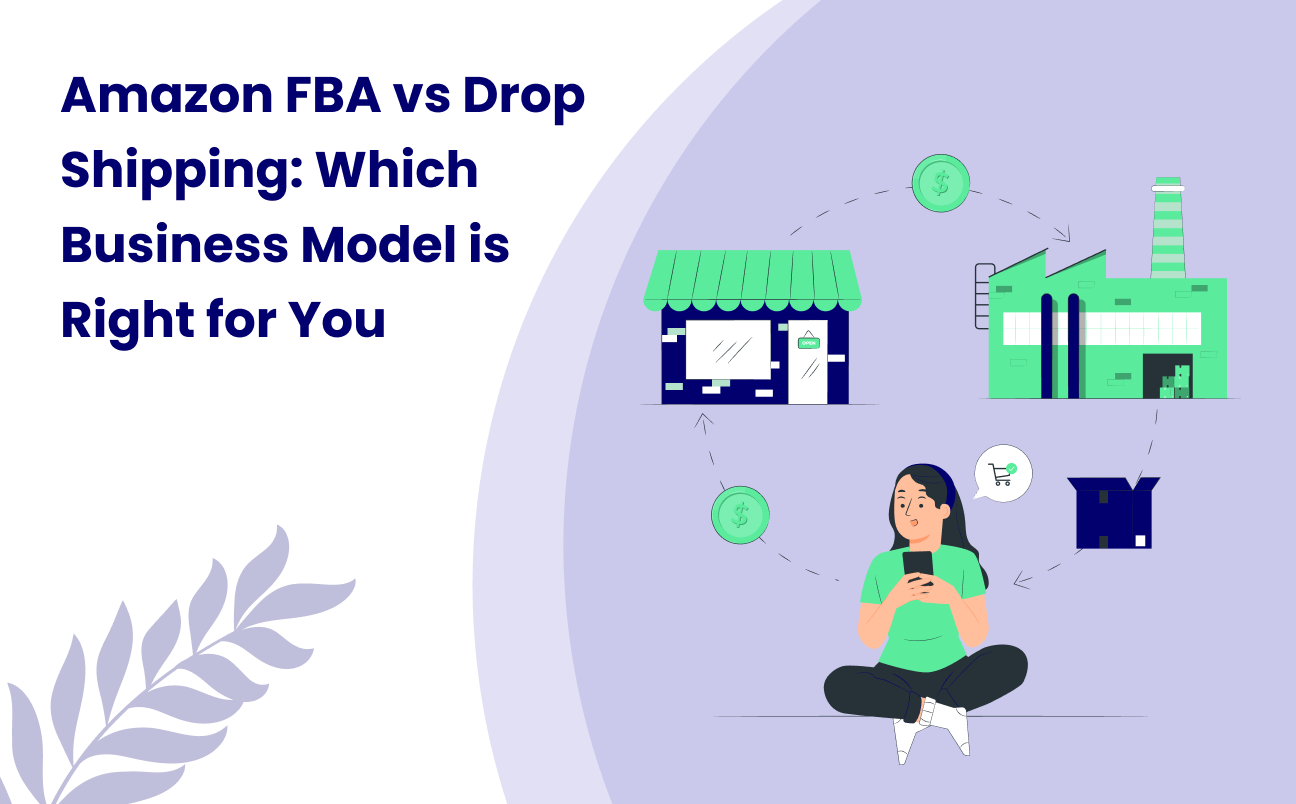Do you want to launch a web presence but are unsure between Amazon FBA vs dropshipping in 2023 and which approach to use?
The worldwide e-commerce business will reach a record $6.5 trillion in 2023, so entrepreneurs are eager to capitalize on the trend. Yet, choosing between Amazon FBA vs dropshipping might be difficult because each marketing strategy has benefits and drawbacks.
Almost 200,000 merchants use Amazon FBA to expand their businesses globally, and third-party merchants account for more than 50% of Amazon’s overall sales, as shown by a recent poll.
Dropshipping has also become more popular, and by 2025, it is predicted that the sector will be worth $557.9 billion. Over 22 million online shops employ the dropshipping method worldwide, including 27% of online retailers in the US adopting it as their principal method of order fulfillment.
The simplicity to enter and achieve the potential of these business models have contributed to their increasing popularity. Yet, each structure has particular benefits and drawbacks, so picking the best one for your company can significantly affect how well it does.
What is Meant by Amazon FBA?
E-commerce has transformed thanks to Amazon FBA, which has made it simpler and much more effective for websites to connect consumers all over the globe. FBA is a solution that features and lets you market your brands on Amazon’s marketplace. At the same time, Amazon handles all of the fulfillment-related details, such as choosing, assembling, packing, and shipping your goods from fulfillment centers.
Amazon FBA will help you manage your company’s daily tasks more effectively and less stressfully. By paying Amazon to manage your company’s needs and requirements through FBA, you can concentrate on building your brand and diversifying your product offers.
Let’s Examine the FBA Process in More Detail to Understand Better How FBA Functions.
1. Vendors will deliver their stock to Amazon’s fulfillment centers.
2. Amazon will receive, sort, and store it in fulfillment centers
3. Clients will buy the vendor’s goods from Amazon’s online marketplaces.
4. Amazon FBA will choose, package, and deliver the item after a purchase order.
5. Amazon FBA will handle customer support.
6. Amazon FBA will handle any returns that the consumer requests.
Advantages and Disadvantages of Amazon FBA
FBA is a full fulfillment service with lots of benefits for merchants. FBA has certain drawbacks in addition to all its benefits. Let’s discuss them.
Advantages:
- Ease: Amazon picks, packs, and ships merchants’ merchandise to its fulfillment centers.
- Strengthen Your Products: Whenever Amazon delivers your goods, the Prime delivery emblem appears on your product listings.
- Prime Badge: Whenever consumers see the Prime mark, they will have more confidence in your goods. The client knows they will obtain their order in a couple of days.
- Assured Customer Support: Amazon will manage all customer service for orders it has fulfilled.
- Returns: Amazon handles processing any return if a client has to return something.
- Multi-Channel Fulfillment: With multi-channel fulfillment, merchants utilize Amazon FBA to complete orders on other e-commerce websites.
Disadvantages:
- Constant Price for Amazon FBA: There are fees associated with Amazon FBA. The essential costs are selecting and packaging, periodic storage, and long-term and fulfillment charges. All of these indicate that you will have to pay charges according to the number of your goods Amazon stores, how long goods are stored, and more.
- Warehousing Costs: Sellers may additionally require monthly warehousing costs and possibly prolonged storage costs if the product is kept for longer than 365 days in addition to FBA costs.
- Maximum Restockings: Amazon has resupply limitations for each storage option. Therefore you might not be able to send as many goods as you want.
- Lost Stock: Throughout the handling process, Amazon might miss a few of your stock but don’t worry, although they’ll compensate you for lost stock.
What is Dropshipping?
A retail fulfillment technique called dropshipping allows businesses to market their goods online without keeping any inventory on hand. Instead, the shop acquires the product from a third-party source and arranges for it to be delivered to the buyer when a client puts an order on the store’s website. As the merchandise is never seen or handled by the merchant, this results in.
In short, dropshipping enables people or companies to sell goods without being concerned about stock control or logistics for shipping. With the growth of e-commerce platforms, this approach has gained popularity. It has made it possible for many business owners to launch their online stores without making an initial investment in inventory.

Let’s examine the drop shipping process in more detail to understand better how dropshipping functions.
- A customer purchases something from your online shop.
- Your shop immediately notifies the dropshipping partner of the purchase.
- Your dropshipping partner processes the order for your client.
- Your dropshipping partner delivers the item to your end consumer.
Advantages and Disadvantages of Dropshipping
Advantages:
- Reduced Management
Whenever a consumer purchases dropshipping, you are required to submit the distributor with the exact order. Package, shipment, and refund management are all handled by your supplier.
- Low Expenses
Compared to other company models like brands or wholesale, this one has lower initial expenses because there are no large advanced orders for goods or upfront payments of hundreds of thousands of dollars.
- Low Entrance Obstacles
Starting is simpler because you can discover items from a source and post those on Amazon or any other platform immediately.
- Diversity of Products
Dropshipping makes it easier to broaden your goods offering than managing your inventory because it requires less investment.
Disadvantages:
- Smaller Profits
Lesser money is invested, so lesser money is earned. Given that the provider receives most of your revenue, you must conduct most operations to remain solvent.
- Customer Support Problems
Dropshipping gives you more autonomy over how you manage your goods, yet it may become out of your grasp when responding to consumer concerns. To complete tasks, you must depend on your vendors. Hence, it’s possible that you won’t be able to successfully handle consumer complaints without having excellent support.
- Huge Rivalry
There is a great deal of rivalry in dropshipping. Many merchants are making an effort to offer a comparable business strategy. In attempting to market their products, some vendors may even attempt to sacrifice their earnings.
- Lack of Product Expertise
Distributors may often fail to give you all the necessary product information. There is a reasonable probability that you may find it challenging to respond to client questions about your items.
What Distinguishes Dropshipping from Amazon FBA?
The only difference between these two fulfillment strategies is who controls the stock. Both allow you to delegate the process of fulfilling consumer purchases to another business. Here is a distinction between Amazon FBA and dropshipping based on the stock’s owner, delivery of goods, and customer care.
- Stock’s Owner: Dropshipping and Amazon FBA are different because, with FBA, you possess the stock and use Amazon’s fulfillment system to manage your shipments. For example, when offering private brand goods, you would make an advance large bulk purchase with a manufacturer and ship the stock to an Amazon FBA fulfillment center.
- Delivery of the Goods: While dropshipping, you wait to pay for stock till a buyer makes a purchase. If you get a request for an item you have advertised for purchase, you have to submit an order to the provider, and they’ll deliver the goods to your consumer.
- Customer Care: While utilizing FBA, Amazon will handle refunds and customer support on your behalf.
- Refunds: When a customer makes a refund in case of the dropshipping seller is responsible for the return and customer service. The seller cannot send goods back to the supplier.
Amazon FBA vs Dropshipping: Which is Perfect Fit for Your Business
Amazon FBA vs dropshipping have their own perks and drawbacks, so which model is best for your company ultimately relies on your objectives and available resources.
Amazon FBA can be a better alternative if you have the money to invest upfront and want more control over your inventory and shipping procedures. With FBA, you have exposure to Amazon’s substantial consumer base, effective shipping network, support staff, and return services.
On the other hand, dropshipping could be the best option if you have a tight budget and want to reduce risk. Dropshipping eliminates the need for upfront inventory expenditures and actual warehouse management because the provider will take care of your transportation and inventory management.
The top Amazon account management services are what we offer at HRL Infotechs the best ecommerce marketing agency. To assist companies in managing their inventory, shipping, and customer care, we provide Amazon FBA services. Our services can assist companies in streamlining their processes so they can concentrate on expansion and revenue.
